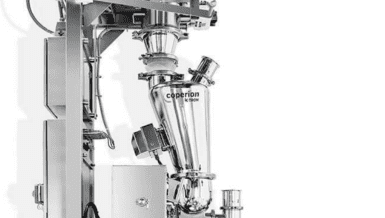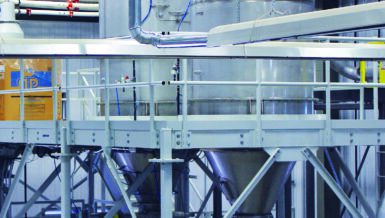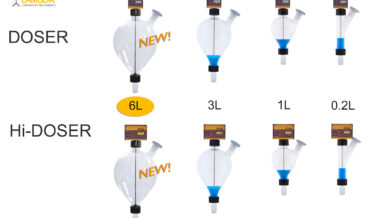Manufacturers like Eriez continue to advance the design of vibratory feeders to evolve and meet the food industry’s needs and regulatory challenges. These include following guidelines for Safe Quality Foods (SQF), Good Manufacturing Practices (GMP) and sanitation requirements.
There are multiple areas along the food processing line where electromagnetic vibratory feeders are utilized:
- Baking or freezing – Feeder models are available for high-temperature installations with ambient temperatures approaching 300 degrees F and cold temperatures approaching 20 to 32 degrees F.
- Screening for fine debris and oversized material removal – Vibratory equipment adapts easily to the addition of a screening function during the conveying process. Common applications include “scalping” or removing oversized material from the product and “de-dusting” or removing fines from the product.
- Metering material at a controlled rate – In a food processing plant, vibratory feeders are commonly used to meter material into downstream processing equipment. The vibratory feeder acts as the bulk metering device to provide material at a controllable, easily adjusted rate.
- Cleanliness and sanitation – One of the primary benefits of vibratory feeders in the food industry is the simple construction of the feeder tray. With no complex geometric barriers, trays can be easily and quickly wiped down or washed out for product changeover.
Choosing the right feeder
Each vibratory feeder is designed with a different amplitude, frequency and angle of deflection to move different materials at specific rates. The design is based on many factors, including the food material being processed, flow rate of the process, nature of the environment, need to start and stop the process, cost to operate the equipment and likelihood of repairs.
With those factors in mind, choosing the right feeder in food processing applications comes down to several types of models:
- High-speed feeders are an excellent choice for applications where fast travel speeds and frequent starts and stops are necessary. These units are ideally suited for food packaging.
- High amplitude/low frequency feeders are the typical choice for handling light and bulky, fine powdery and flexible products, including cereal, flaky and powder spices, potato chips, raisins, gummy candy and more. These units are the preferred choice for adding a screening function to the conveying process.
- Low amplitude, high frequency feeders are ideal for use with free-flowing materials that have a bulk density above 20 pounds per cubic foot.
Consistency and quality of a finished product is integral in the food industry. Electromagnetic feeders offer food processors several opportunities to improve their facility’s efficiency.
- Electromagnetic feeders under a hopper allow for ingredients to be supplied to blenders and mixers with ease.
- Electromagnetic scarf plate feeders can sprinkle granular material like salt, sugar and seasoning onto snack food or baked goods traveling on a belt conveyor, ensuring consistent coating on the product.
- Adding a hopper above an electromagnetic feeder, also known as a Volumatic Feeder Machine, can be used with weigh scales, batch operations and operations where additive feeding is performed either continuously or intermittently.
Customizable tray designs
The shape, length and width of feeder trays are practically limitless. Customers can order trays with features to satisfy their unique food process requirements. Every configuration of flat, curved, v-channel and tubular designs is available. Trays are typically fabricated from stainless steel for food applications.
Trays that include features such as a tray cover or screen deck incorporate quick-release fasteners that enable removal of these components without tools. Once fasteners are loosened, the component simply lifts and disconnects from the tray for easier cleaning.
Technology advances make electromagnetic vibratory feeding solutions more applicable than ever for food industry environments. Sanitary construction, ease of cleaning, low maintenance and latest design features make these units an ideal choice for facilities where greater product purity, energy cost savings, decreased equipment maintenance expense and streamlined manufacturing operations are desired.











































